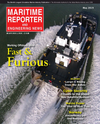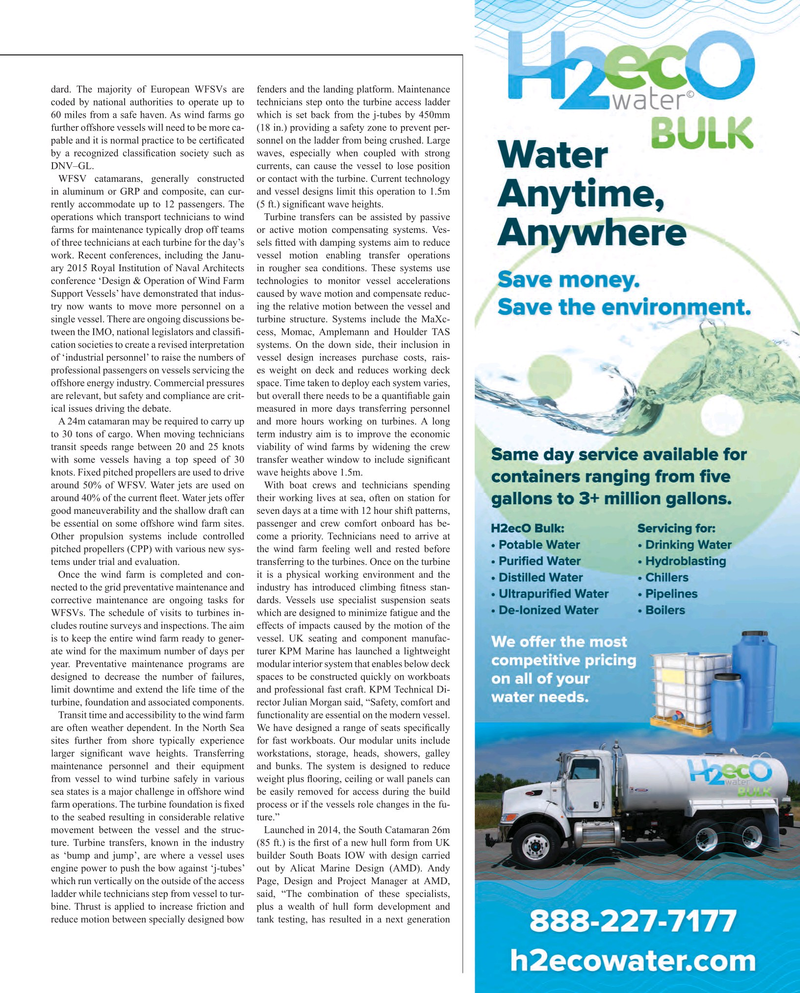
Page 39: of Maritime Reporter Magazine (May 2015)
The Marine Propulsion Edition
Read this page in Pdf, Flash or Html5 edition of May 2015 Maritime Reporter Magazine
dard. The majority of European WFSVs are fenders and the landing platform. Maintenance coded by national authorities to operate up to technicians step onto the turbine access ladder 60 miles from a safe haven. As wind farms go which is set back from the j-tubes by 450mm further offshore vessels will need to be more ca- (18 in.) providing a safety zone to prevent per- pable and it is normal practice to be certi? cated sonnel on the ladder from being crushed. Large by a recognized classi? cation society such as waves, especially when coupled with strong
DNV–GL. currents, can cause the vessel to lose position
WFSV catamarans, generally constructed or contact with the turbine. Current technology in aluminum or GRP and composite, can cur- and vessel designs limit this operation to 1.5m rently accommodate up to 12 passengers. The (5 ft.) signi? cant wave heights. operations which transport technicians to wind Turbine transfers can be assisted by passive farms for maintenance typically drop off teams or active motion compensating systems. Ves- of three technicians at each turbine for the day’s sels ? tted with damping systems aim to reduce work. Recent conferences, including the Janu- vessel motion enabling transfer operations ary 2015 Royal Institution of Naval Architects in rougher sea conditions. These systems use conference ‘Design & Operation of Wind Farm technologies to monitor vessel accelerations
Support Vessels’ have demonstrated that indus- caused by wave motion and compensate reduc- try now wants to move more personnel on a ing the relative motion between the vessel and single vessel. There are ongoing discussions be- turbine structure. Systems include the MaXc- tween the IMO, national legislators and classi? - cess, Momac, Amplemann and Houlder TAS cation societies to create a revised interpretation systems. On the down side, their inclusion in of ‘industrial personnel’ to raise the numbers of vessel design increases purchase costs, rais- professional passengers on vessels servicing the es weight on deck and reduces working deck offshore energy industry. Commercial pressures space. Time taken to deploy each system varies, are relevant, but safety and compliance are crit- but overall there needs to be a quanti? able gain ical issues driving the debate. measured in more days transferring personnel
A 24m catamaran may be required to carry up and more hours working on turbines. A long to 30 tons of cargo. When moving technicians term industry aim is to improve the economic transit speeds range between 20 and 25 knots viability of wind farms by widening the crew with some vessels having a top speed of 30 transfer weather window to include signi? cant knots. Fixed pitched propellers are used to drive wave heights above 1.5m.
around 50% of WFSV. Water jets are used on With boat crews and technicians spending around 40% of the current ? eet. Water jets offer their working lives at sea, often on station for good maneuverability and the shallow draft can seven days at a time with 12 hour shift patterns, be essential on some offshore wind farm sites. passenger and crew comfort onboard has be-
Other propulsion systems include controlled come a priority. Technicians need to arrive at pitched propellers (CPP) with various new sys- the wind farm feeling well and rested before tems under trial and evaluation. transferring to the turbines. Once on the turbine
Once the wind farm is completed and con- it is a physical working environment and the nected to the grid preventative maintenance and industry has introduced climbing ? tness stan- corrective maintenance are ongoing tasks for dards. Vessels use specialist suspension seats
WFSVs. The schedule of visits to turbines in- which are designed to minimize fatigue and the cludes routine surveys and inspections. The aim effects of impacts caused by the motion of the is to keep the entire wind farm ready to gener- vessel. UK seating and component manufac- ate wind for the maximum number of days per turer KPM Marine has launched a lightweight year. Preventative maintenance programs are modular interior system that enables below deck designed to decrease the number of failures, spaces to be constructed quickly on workboats limit downtime and extend the life time of the and professional fast craft. KPM Technical Di- turbine, foundation and associated components. rector Julian Morgan said, “Safety, comfort and
Transit time and accessibility to the wind farm functionality are essential on the modern vessel. are often weather dependent. In the North Sea We have designed a range of seats speci? cally sites further from shore typically experience for fast workboats. Our modular units include larger signi? cant wave heights. Transferring workstations, storage, heads, showers, galley maintenance personnel and their equipment and bunks. The system is designed to reduce from vessel to wind turbine safely in various weight plus ? ooring, ceiling or wall panels can sea states is a major challenge in offshore wind be easily removed for access during the build farm operations. The turbine foundation is ? xed process or if the vessels role changes in the fu- to the seabed resulting in considerable relative ture.” movement between the vessel and the struc- Launched in 2014, the South Catamaran 26m ture. Turbine transfers, known in the industry (85 ft.) is the ? rst of a new hull form from UK as ‘bump and jump’, are where a vessel uses builder South Boats IOW with design carried engine power to push the bow against ‘j-tubes’ out by Alicat Marine Design (AMD). Andy which run vertically on the outside of the access Page, Design and Project Manager at AMD, ladder while technicians step from vessel to tur- said, “The combination of these specialists, bine. Thrust is applied to increase friction and plus a wealth of hull form development and reduce motion between specially designed bow tank testing, has resulted in a next generation
MR #5 (34-41).indd 39 MR #5 (34-41).indd 39 5/1/2015 3:10:59 PM5/1/2015 3:10:59 PM

 38
38

 40
40
